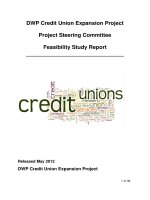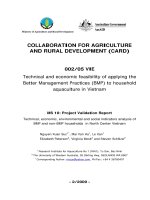PROJECT FEASIBILITY 2
Bạn đang xem bản rút gọn của tài liệu. Xem và tải ngay bản đầy đủ của tài liệu tại đây (161.21 KB, 50 trang )
PROJECT FEASIBILITY
“Does
the Input =the Output?”
or
“Can It Work?”
The Stages of the Development Process
•
•
•
•
Creating the Concept
Testing the market
Evaluate Site Costs
Pro Forma
– Income
– Expenses
• Finding Tenants
• Permanent Financing
• Construction Finance
• “Gap” Financing
• Construction
– Under Budget
– Within schedule
• Managing Property
• Selling the Asset
• Starting Over
Sponsored by:
U. S. Department of Housing and Urban
Development
TDA, Inc.
Presented by:
Logistics
Agenda
Handouts
Breaks
Restrooms
Questions
“Parking Lot”
Who is here?
Introductions
Session Rules
Keep it informal
Ask questions
Share your experience
Use your manual - take notes on the
pages
Enjoy the number crunching
Module 1
Underwriting
What is Underwriting?
– Determining facts
– Making reasonable assumptions
– Analyzing risks
– Making recommendations to minimize
risks
Public v. Conventional
Conv. Lenders
consider:
• market risk
• borrower risk
• project risk
• portfolio risk
Public Lenders also
consider:
• public purpose
• regulatory compliance
• affordability
• gap analysis
Market Risk
• Rent-up risk
• Maintenance of occupancy & rents
• Maintenance of collateral value
Borrower Risk
The Five C’s:
–
–
–
–
–
Cash
Capability
Creditworthiness
Character
Collateral
Project Risk
• Completion risk
• Financial feasibility risk
• Collateral risk
The Shift to “Market”
• Market v. jurisdiction/service area
• Customers v. clients
• Product v. service
• Demand v. needs
• if we build it, they will come
• LI housing doesn’t have to compete
Market Risks
•
•
•
•
•
•
Rents above market
Rents unaffordable
Excess capacity; slow absorption
Competitive disadvantage
Market won’t sustain occupancy
Property won’t maintain value
Scope of Borrower Analysis
Assessing risks that the borrower will
complete the project, considering:
• Organizational structure
• Business experience & qualifications
• Financial condition & prospects
• General credit history
Key Borrower Questions
• What type of borrower?
– New v. existing entities
– For-profits v. not-for-profits
• Who are the “key principals”?
– Creditworthiness of principals
– Personal liability
– Recapture requirements
Five C’s of Borrower Risk
•
•
•
•
•
Cash
Collateral
Creditworthiness
Capability
Character
Cash: Equity & Liquidity
• How much equity is committed
• Timing, amount & source of equity
– Cash
– Land
– Contribution of Fees
• What else is available...if needed?
Collateral
• Completion guarantee
• Operating guarantee
• Portfolio:
– Overall stability, profitability, liquidity &
vulnerability of other assets in portfolio
– Diversification of portfolio
– Other direct & contingent liabilities
– Cross-collateralization
What to Look at: Collateral
•
•
•
•
•
•
•
Net worth
Schedule of real estate investments
Notes on contingent liabilities
Level of reserves/escrows
Potential refinancings (e.g., balloons)
Trends in property cash flows
Market factors
Creditworthiness
•
•
•
•
Loan payment history
Current debt load
Current performance
Discrepancies
Capability
•
•
•
•
•
•
Legal entity
Experience: projects of similar scope
Prior collaboration of team members
Loan history (incl. defaults)
Property management performance
Not-for-profit issues
How to look at Capability
•
•
•
•
Financial statements: debt load
Credit report: payment history
Lender contacts
Property inspections
Character
• Subjective judgments:
– Likelihood to perform/stick with it
– Integrity/live up to commitments
• Look at:
– Past development performance
– Physical/management condition
– References on past debt performance &
problem resolution
Financial Statements
• Used to identify “current” problems
– losing $$ on operations
– not enough cash to meet obligations
• Used to identify “potential problems”
– look at trends
• Used to identify “source of problems”
Module 2
Analyzing Project Risk









